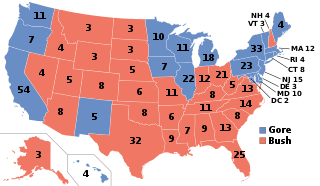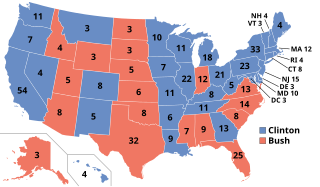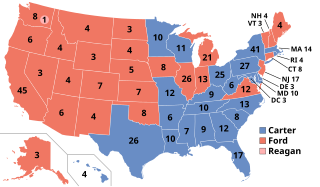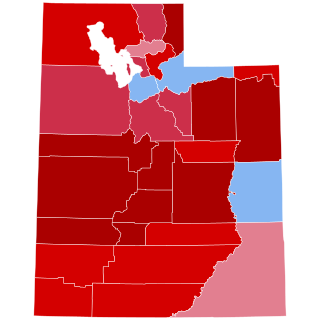
The 2000 United States presidential election was the 54th quadrennial presidential election, held on Tuesday, November 7, 2000. Republican candidate George W. Bush, the governor of Texas and eldest son of the 41st president, George H. W. Bush, won the election, defeating incumbent Vice President Al Gore. It was the fourth of five American presidential elections, and the first since 1888, in which the winning candidate lost the popular vote, and is considered one of the closest elections in US history, with longstanding controversy surrounding the ultimate results.

The 1996 United States presidential election was the 53rd quadrennial presidential election, held on Tuesday, November 5, 1996. Incumbent Democratic President Bill Clinton defeated former Senate Majority Leader Bob Dole, the Republican nominee, and Ross Perot, the Reform Party nominee.

The 1992 United States presidential election was the 52nd quadrennial presidential election, held on Tuesday, November 3, 1992. Democratic Governor Bill Clinton of Arkansas defeated incumbent Republican President George H. W. Bush, independent businessman Ross Perot of Texas, and a number of minor candidates. The election marked the end of a period of Republican dominance in American presidential politics that began in 1968, and also marked the end of 12 years of Republican rule of the White House, as well as the end of the Greatest Generation's 32-year American rule and the beginning of the Baby boomers 28-year dominance until 2020. It was the last time the incumbent president failed to win a second term until 2020, when Donald Trump lost the election to Joe Biden; it was the first such occurrence since 1980.

The 1976 United States presidential election was the 48th quadrennial presidential election. It was held on Tuesday, November 2, 1976. Democrat Jimmy Carter of Georgia defeated incumbent Republican President Gerald Ford from Michigan by a narrow victory of 297 electoral college votes to Ford's 240. This is the most recent presidential election, and the first since 1920, in which both major-party candidates for vice-president would go on to become the presidential nominee for their party in a later election.

The 1984 United States presidential election was the 50th quadrennial presidential election. It was held on Tuesday, November 6, 1984. Incumbent Republican President Ronald Reagan defeated Democratic former Vice President Walter Mondale, in a landslide, winning 525 electoral votes and 58.8 percent of the popular vote. No other candidate in history has matched Reagan's electoral vote total. This is the most recent US presidential election in which a candidate received over 500 electoral votes and the last time that a major party candidate failed to carry more than 100 electoral votes. This is the most recent election where both candidates are deceased.

The United States Electoral College is the group of presidential electors required by the Constitution to form every four years for the sole purpose of appointing the president and vice president. Each state and the District of Columbia appoints electors pursuant to the methods described by its legislature, equal in number to its congressional delegation. Federal office holders, including senators and representatives, cannot be electors. Of the current 538 electors, an absolute majority of 270 or more electoral votes is required to elect the president and vice president. If no candidate achieves an absolute majority there, a contingent election is held by the United States House of Representatives to elect the president, and by the United States Senate to elect the vice president.

The presidential primary elections and caucuses held in the various states, the District of Columbia, and territories of the United States form part of the nominating process of candidates for United States presidential elections. The United States Constitution has never specified the process; political parties have developed their own procedures over time. Some states hold only primary elections, some hold only caucuses, and others use a combination of both. These primaries and caucuses are staggered, generally beginning sometime in January or February, and ending about mid-June before the general election in November. State and local governments run the primary elections, while caucuses are private events that are directly run by the political parties themselves. A state's primary election or caucus is usually an indirect election: instead of voters directly selecting a particular person running for president, they determine the number of delegates each party's national convention will receive from their respective state. These delegates then in turn select their party's presidential nominee. The first state in the United States to hold its presidential primary was North Dakota in 1912, following on Oregon's successful implementation of its system in 1910.

The 2008 United States presidential election was the 56th quadrennial presidential election, held on Tuesday, November 4, 2008. The Democratic ticket of Barack Obama, the junior senator from Illinois, and Joe Biden, the senior senator from Delaware, defeated the Republican ticket of John McCain, the senior senator from Arizona, and Sarah Palin, the governor of Alaska. Obama became the first African American to be elected to the presidency, as well as being only the third sitting United States senator elected president, joining Warren G. Harding and John F. Kennedy. Meanwhile, Biden became the first senator running mate of a senator elected president since Lyndon B. Johnson in the 1960 election.

FairVote, formerly the Center for Voting and Democracy, is a 501(c)(3) organization that advocates electoral reform in the United States.

The Delaware Plan is a proposed system to reorganize the state presidential primary elections amongst the 50 states and the several territories of the United States. In brief, the Plan divides the states and territories into four groups, and has the territories and smallest states voting first and the largest states voting last.
The Rotating Regional Primary System is a proposed system for reform of the United States presidential primary process, in which the country would be divided into four regions for primary elections. The plan has been promoted since 1999 by the National Association of Secretaries of State.
A national primary is a proposed system for conducting the United States presidential primaries and caucuses, such that all occur on the same day.
The Interregional Primary Plan is a proposed reform to the United States primary calendar supported by Representative Sandy Levin and Senator Bill Nelson, both Democrats. The plan would break the country into six regions. From those regions, one subregion - either a single state or a group of smaller states - would vote on each primary date with the entire country having held its primaries after the sixth set of primaries votes. Each state would vote first once every twenty-four years, with the first set of primaries determined by lottery and cycled thereafter.

The election of the president and the vice president of the United States is an indirect election in which citizens of the United States who are registered to vote in one of the fifty U.S. states or in Washington, D.C., cast ballots not directly for those offices, but instead for members of the Electoral College. These electors then cast direct votes, known as electoral votes, for president, and for vice president. The candidate who receives an absolute majority of electoral votes is then elected to that office. If no candidate receives an absolute majority of the votes for president, the House of Representatives elects the president; likewise if no one receives an absolute majority of the votes for vice president, then the Senate elects the vice president.
This article contains lists of official and potential third party and independent candidates associated with the 2016 United States presidential election.

The 2020 United States presidential election in Kentucky was held on Tuesday, November 3, 2020, as part of the 2020 United States presidential election in which all 50 states plus the District of Columbia participated. Kentucky voters chose electors to represent them in the Electoral College via a popular vote, pitting the Republican Party's nominee, incumbent President Donald Trump, and running mate Vice President Mike Pence against Democratic Party nominee, former Vice President Joe Biden, and his running mate California Senator Kamala Harris. Kentucky has eight electoral votes in the Electoral College.

The 2020 United States presidential election in Tennessee was held on Tuesday, November 3, 2020, as part of the 2020 United States presidential election in which all 50 states plus the District of Columbia participated. Tennessee voters chose electors to represent them in the Electoral College via a popular vote, pitting the Republican Party's nominee, incumbent President Donald Trump, and running mate Vice President Mike Pence against Democratic Party nominee, former Vice President Joe Biden, and his running mate California Senator Kamala Harris. Tennessee has 11 electoral votes in the Electoral College.

The 2020 United States presidential election in Nevada was held on Tuesday, November 3, 2020, as part of the 2020 United States presidential election in which all 50 states plus the District of Columbia participated. Nevada voters chose electors to represent them in the Electoral College via a popular vote, pitting the Republican Party's nominee, incumbent President Donald Trump, and running mate Vice President Mike Pence against Democratic Party nominee, former Vice President Joe Biden, and his running mate California Senator Kamala Harris. Nevada has six votes in the Electoral College.

The 2020 United States presidential election in Utah was held on Tuesday, November 3, 2020, as part of the 2020 United States presidential election in which all 50 states plus the District of Columbia participated. Utah voters chose electors to represent them in the Electoral College via a popular vote, pitting the Republican Party's nominee, incumbent President Donald Trump, and running mate Vice President Mike Pence against Democratic Party nominee, former Vice President Joe Biden, and his running mate California Senator Kamala Harris. Utah has six electoral votes in the Electoral College.

The 2020 United States presidential election in Nebraska was held on Tuesday, November 3, 2020, as part of the 2020 United States presidential election in which all 50 states plus the District of Columbia participated. Nebraska voters chose electors to represent them in the Electoral College via a popular vote, pitting the Republican Party's nominee, incumbent President Donald Trump, and running mate Vice President Mike Pence against Democratic Party nominee, former Vice President Joe Biden, and his running mate California Senator Kamala Harris. Nebraska has five electoral votes in the Electoral College, two from the state at large, and one each from the three congressional districts.
















